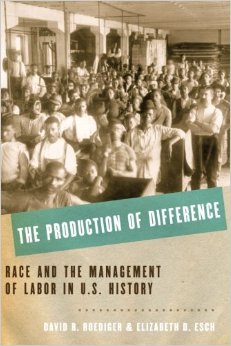
Within progressive, labor, social and economic justice circles the concept of “divide and conquer” is nothing new. It is widely accepted that workers have historically faced discrimination, people of color and women being the most exploited. In fact, whether free or slave, distinctions and differences have, undoubtedly, always served to divide workers, while bolstering and perpetuating profits.
David R. Roediger and Elizabeth D. Esch in their groundbreaking new book The Production Of Difference: Race And The Management Of Labor In U.S. History shine a much-needed light on the emergence of “race management” during slavery, Western expansion, and early 20th century industrial production.
Early on they write, “Slave labor and race management were central to how workers came to be bossed. The factory, so often seen as the site of management innovation, long coexisted with the plantation as the main site for the management of large groups of workers in America. If anything, the latter ran ahead of the former in generating thought about management.” In short, they argue, innovations of “race management” among slave owners predated modern industrial capitalism, and thereby laid the groundwork for industrial managers’ ideological justifications for race-based exploitation.
The on-going, open and serious dialogue among slave owners regarding the management of slave labor documented by Roediger and Esch is impressive. Like their modern day counterparts – who publish trade journals, often with insightful glimpses into the business mind – slave owners published numerous journals, magazines and newspapers like, Farmers’ Register, Southern Cultivator, American Cotton Planter, and De Bow’s Review, among others, that “offered extended disquisitions” on the managing of slaves. These same journals would also praise “the managerial virtues of white masters, and indeed of whites as a race, so that the broad idea of ‘whiteness-as-management’ received emphasis.”
Undoubtedly, slave masters viewed themselves not only as owners of human property, but also as “race managers” embracing the “production of difference” as a means to maintain control and generate profits.
Often racism, sexism and the “production of difference” coalesced in so-called “management” journals. For example, “judgments of value and productivity” placed on lighter-skinned African American women, “who often embodied European standards of beauty and were the products of sexual exploitation by masters, attracted higher prices than darker-skinned ‘African’ women.” Conversely, “among male slaves, a light skin generally decreased value as managerial ‘common sense’ dictated that mixed-race [male] slaves were less capable of withstanding hot backbreaking labor…”
It is also worth noting that slave births, according to Roediger and Esch, “probably produced more value than was realized through cotton production” from 1810 on. “The ‘increase’ continually increased,” producing what one scholar called the “sexual economy of American slavery,” probably “the greatest success story in plantation race management.”
Slave masters also often hired out slaves as “a reserve army of labor, providing ‘strike insurance’ and the threat of replacing [white] workers who refused hot and dangerous work,” thereby “undermining the ability of white, often immigrant, workers to effectively make demands for better wages and conditions.” Undoubtedly, “whiteness-as-management” reinforced race and class divisions, and continued as a useful tool long after the end of slavery, as industrialists would eventually utilize similar methods to produce, perpetuate and manage different ethnic races looking for work in mining, steel, auto and other industries.
As Roediger and Esch analyze “race management” during Western expansion other insights are presented. For example, they write, “Railroad construction at times followed the example of slavery in seeking to find a single race best suited to the job and most willing to accept its dangers. Later railway construction management recruited a handful of races and nationalities to ensure labor supply and foster competition.” Asian Americans were often singled out for the hardest, most dangerous jobs, but were often paid the least, while Slavic, Polish, German and Irish whites, among others, were often pitted against each other and African Americans.
It would be impossible to summarize all of the information presented in The Production Of Difference. In fact, I have barely scratched the surface of everything this relatively short book has to offer. Needless to say, Roediger and Esch’s fresh look at an old topic is a thoughtful and detailed analysis of a conscious, systematic effort by slave masters and industrial managers alike to undermine working class solidarity.
The “management of race” and the “production of difference” may very well be terms that redefine our understanding and articulation of “divide and conquer” in the near future. And The Production Of Difference: Race And The Management Of Labor In U.S. History is a must read.
The Production Of Difference: Race And The Management Of Labor In U.S. History
By David R. Roediger and Elizabeth D. Esch
Oxford University Press, 2014, 286 pages










